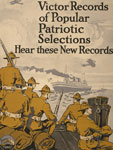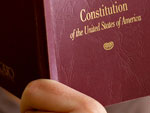Delaware: 4th-Grade Standards
-
DE.4.C1. Content Standard: Civics
Students will examine the structure and purposes of governments with specific emphasis on constitutional democracy.
-
4.C1.1. Performance Indicator / Gle:
Students explain why people have created governments to rule societies.
-
4.C1.2. Performance Indicator / Gle:
Students explain why the U.S. Constitution separates powers between the federal and state governments.
-
4.C1.3. Performance Indicator / Gle:
Students understand that governments have a variety of structures and exist for many purposes and that in America these are explained in the United States and State constitutions.
-
4.C1.4. Performance Indicator / Gle:
Students explain why the U.S. Constitution separates powers in the federal government.
-
4.C1.5. Performance Indicator / Gle:
Students explain how each branch of the U.S. government serves as a check on the other branches.
-
4.C1.6. Performance Indicator / Gle:
Students understand that the United States government is divided into executive, legislative, and judicial branches, each with specific responsibilities and powers.
-
-
DE.4.C2. Content Standard: Civics
Students will understand the principles and ideals underlying the American political system.
-
4.C2.1. Performance Indicator / Gle:
Students explain the principle of 'due process.'
-
4.C2.2. Performance Indicator / Gle:
Students explain why the 'rule of law' is important to citizens.
-
4.C2.3. Performance Indicator / Gle:
Students understand that the principle of 'due process' means that the government must follow its own rules when taking actions against a citizen.
-
4.C2.4. Performance Indicator / Gle:
Students explain why citizens have responsibilities.
-
4.C2.5. Performance Indicator / Gle:
Students explain why personal civility is important to a society.
-
4.C2.6. Performance Indicator / Gle:
Students understand that a society based on the ideal of individual liberty requires a commitment on the part of its citizens to the principles of civic responsibility and personal civility.
-
-
DE.4.C3. Content Standard: Civics
Students will understand the responsibilities, rights, and privileges of United States citizens.
-
4.C3.1. Performance Indicator / Gle:
Students explain why the Bill of Rights is important to American citizens.
-
4.C3.2. Performance Indicator / Gle:
Students identify the fundamental rights of all American citizens as enumerated in the Bill of Rights.
-
4.C3.3. Performance Indicator / Gle:
Students identify controversial applications of the Bill of Rights in contemporary issues.
-
4.C3.4. Performance Indicator / Gle:
Students apply the protections guaranteed in the Bill of Rights to an analysis of everyday situations.
-
-
DE.4.C4. Content Standard: Civics
Students will develop and employ the civic skills necessary for effective, participatory citizenship.
-
4.C4.1. Performance Indicator / Gle:
Students explain why it is important to become informed about candidates for public office and contemporary issues.
-
4.C4.2. Performance Indicator / Gle:
Students explain how a citizen can become informed about candidates for public office and contemporary issues.
-
4.C4.3. Performance Indicator / Gle:
Students understand that in order to select effective leaders, citizens have to become informed about candidates' qualifications and the issues of the day.
-
4.C4.4. Performance Indicator / Gle:
Students explain why different groups would choose to make decisions democratically.
-
4.C4.5. Performance Indicator / Gle:
Students explain how different democratic groups make decisions.
-
4.C4.6. Performance Indicator / Gle:
Students identify and employ the formal and informal methods by which democratic groups function.
-
-
DE.4.E1. Content Standard: Economics
Students will analyze the potential costs and benefits of personal economic choices in a market economy.
-
4.E1.1. Performance Indicator / Gle:
Students predict how choices by consumers and producers in a market economy will determine price of goods and services.
-
4.E1.2. Performance Indicator / Gle:
Students explain why price acts as an incentive for both consumers and producers in a market economy.
-
4.E1.3. Performance Indicator / Gle:
Students identify how shifts in supply or demand can change the price of goods and services.
-
4.E1.4. Performance Indicator / Gle:
Students explain how a government will use economic incentives to promote market efficiency and correct market failures.
-
4.E1.5. Performance Indicator / Gle:
Students understand that prices in a market economy are determined by the interaction of supply and demand, with governments intervening to deal with market failures.
-
4.E1.6. Performance Indicator / Gle:
Students understand that consumers and producers make economic choices based on supply, demand, access to markets, and the actions of government.
-
-
DE.4.E2. Content Standard: Economics
Students will examine the interaction of individuals, families, communities, businesses, and governments in a market economy.
-
4.E2.1. Performance Indicator / Gle:
Students explain why individuals might save, invest, or borrow money.
-
4.E2.2. Performance Indicator / Gle:
Students explain how saving or borrowing money benefits the economy.
-
4.E2.3. Performance Indicator / Gle:
Students understand the role of banks and other financial institutions in the economy.
-
-
DE.4.E3. Content Standard: Economics
Students will understand different types of economic systems and how they change.
-
4.E3.1. Performance Indicator / Gle:
Students explain the differences between types of economic systems.
-
4.E3.2. Performance Indicator / Gle:
Students identify different ways goods and services have been exchanged, characteristics of money, and functions of money.
-
4.E3.3. Performance Indicator / Gle:
Students identify different means of production, distribution, and exchange used within economic systems in different times and places.
-
-
DE.4.E4. Content Standard: Economics
Students will examine the patterns and results of international trade.
-
4.E4.1. Performance Indicator / Gle:
Students explain why people specialize and trade.
-
4.E4.2. Performance Indicator / Gle:
Students explain how trade creates interdependence.
-
4.E4.3. Performance Indicator / Gle:
Students demonstrate how international trade links countries around the world and can improve the economic welfare of nations.
-
-
DE.4.G1. Content Standard: Geography
Students will develop a personal geographic framework, or 'mental map', and understand the uses of maps and other geographics.
-
4.G1.1. Performance Indicator / Gle:
Students apply mental maps to ask and answer questions that require awareness of the relative location of places.
-
4.G1.2. Performance Indicator / Gle:
Students demonstrate the ability to locate places on maps and globes using a grid system such as latitude and longitude.
-
4.G1.3. Performance Indicator / Gle:
Students identify the contrasts between maps of different scales and projections.
-
4.G1.4. Performance Indicator / Gle:
Students demonstrate development of mental maps of Delaware and of the United States which include the relative location and characteristics of major physical features, political divisions, and human settlements.
-
-
DE.4.G2. Content Standard: Geography
Students will develop a knowledge of the ways humans modify and respond to the natural environment.
-
4.G2.1. Performance Indicator / Gle:
Students identify ways in which physical features can be altered by human activity.
-
4.G2.2. Performance Indicator / Gle:
Students explain how humans have adapted to different environments.
-
4.G2.3. Performance Indicator / Gle:
Students predict how an environmental change will affect humans and how human activity can cause environmental change.
-
4.G2.4. Performance Indicator / Gle:
Students apply a knowledge of topography, climate, soils and vegetation of Delaware and the United States to understand how human society alters, and is affected by, the physical environment.
-
-
DE.4.G3. Content Standard: Geography
Students will develop an understanding of the diversity of human culture and the unique nature of places.
-
4.G3.1. Performance Indicator / Gle:
Students explain the concepts of site and situation.
-
4.G3.2. Performance Indicator / Gle:
Students apply site and situation to explain why places are of different size and different levels of economic activity.
-
4.G3.3. Performance Indicator / Gle:
Students understand the reasons for the locations of human activities and settlements and the routes connecting them in Delaware and the United States.
-
-
DE.4.G4. Content Standard: Geography
Students will develop an understanding of the character and use of regions and the connections between and among them.
-
4.G4.1. Performance Indicator / Gle:
Students explain why a place is unique.
-
4.G4.2. Performance Indicator / Gle:
Students explain how a place changes over time.
-
4.G4.3. Performance Indicator / Gle:
Students explain how a place's distinctiveness is affected by its location relative to larger physical, cultural, political, and economic regions.
-
4.G4.4. Performance Indicator / Gle:
Students apply geographic skills to develop a profile of the local community by placing it in the context of physical, cultural and other types of regions.
-
-
DE.4.H1. Content Standard: History
Students will employ chronological concepts in analyzing historical phenomena.
-
4.H1.1. Performance Indicator / Gle:
Students create a chronology from selected historical materials.
-
4.H1.2. Performance Indicator / Gle:
Students predict cause or effect from a chronology and selected historical materials.
-
4.H1.3. Performance Indicator / Gle:
Students study historical events and persons within a given time-frame in order to create a chronology and identify related cause-and-effect factors.
-
-
DE.4.H2. Content Standard: History
Students will gather, examine, and analyze historical data.
-
4.H2.1. Performance Indicator / Gle:
Students explain why a historical source would be considered either a primary or secondary historical source.
-
4.H2.2. Performance Indicator / Gle:
Students explain how a specific historical source would be used to draw a historical conclusion.
-
4.H2.3. Performance Indicator / Gle:
Students identify artifacts and documents as either primary or secondary sources of historical data from which historical accounts are constructed.
-
4.H2.4. Performance Indicator / Gle:
Students arrange selected historical sources chronologically.
-
4.H2.5. Performance Indicator / Gle:
Students identify cause and effect from chronologically arranged historical sources.
-
4.H2.6. Performance Indicator / Gle:
Students examine historical materials relating to a particular region, society, or theme; chronologically arrange them, and analyze change over time.
-
-
DE.4.H3. Content Standard: History
Students will interpret historical data.
-
4.H3.1. Performance Indicator / Gle:
Students explain why point of view can alter historical accounts.
-
4.H3.2. Performance Indicator / Gle:
Students explain why using different historical evidence can alter historical accounts.
-
4.H3.3. Performance Indicator / Gle:
Students explain why historical accounts of the same event sometimes differ and will relate this explanation to the evidence presented or the point-of-view of the author.
-



